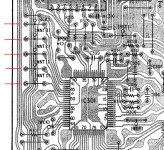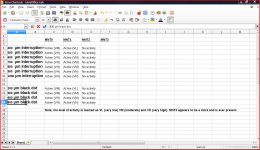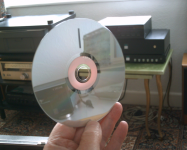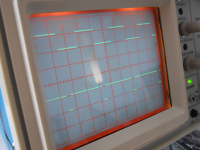Why?
Error correction happens inside the decoder IC (CXD2500 in your case), there's no need to go thru several analog stages and another sampling process which might mask the effect you're trying to uncover.
Why ! Because my digital hardware is pretty limited. I've no means to take an SPDIF signal direct to my PC.
Perhaps the differences you have observed really are down to the disc errors. I could a double take of the same track (the one with no errors) as a test. They should (if the method works) align perfectly.
I looked yesterday at the CXD2500 pinouts but couldn;t see anything useful. The main micro does have a 'defect' output, but that is only used to alter the servo gain.
BTW, Moooly, your CD player is perfect candidate to become a CD quality control machine - it has C1 and C2 error monitoring test points on PCB!
See PDF p.32 for description
Lol, I was looking again as you typed this. Let me take a look.
Interesting. I'll perhaps rig it up with the scope later. I was looking at the GFS (guarded frame sync) pin as well.
I'll study that.
I'll study that.
just had a quick read of p32.BTW, Moooly, your CD player is perfect candidate to become a CD quality control machine - it has C1 and C2 error monitoring test points on PCB!
See PDF p.32 for description
Now I know why I never became any good at digital.
I think I'll stay with analogue until I find a recommended digital "kit" that is guaranteed to work by following the comprehensive build instructions.
Mooly, you will need some glue logic to monitor for specific conditions (see table in CXD2500 datasheet).
Four input AND gate will do to see when all four pins MNT0 to MNT3 are high (uncorrectable C2 error).
Untitled Document
Search the WEB, I think I saw some error checker schematics published.
Four input AND gate will do to see when all four pins MNT0 to MNT3 are high (uncorrectable C2 error).
Untitled Document
Search the WEB, I think I saw some error checker schematics published.
Last edited:
Mooly, you will need some glue logic to monitor for specific conditions (see table in CXD2500 datasheet).
Four input AND gate will do to see when all four pins MNT0 to MNT3 are high (uncorrectable C2 error).
Untitled Document
Search the WEB, I think I saw some error checker schematics published.
Thanks 🙂
I thought of knocking some monostables together to stretch the pulses but I've come up with a modified disc that sends the MNT2 flag crazy when viewed on a scope. MNT3 flag is an ever present clock signal, its there even in stop mode.
Attachments
When ripping, use EAC and a drive that supports reporting C2 errors. This way it is fast and you know the data is not corrupt.
Some time ago I burnt a CD, ripped it via SPDIF (from CDP to PC), then compared the bits. Then I scratched the CD and tried again. There were no read errors until the damage to the CD got pretty high...
CD audio uses two layers of interleaved error correction codes. It is pretty robust. Any $2 CD pickup-drive assembly can read a CD just fine, the digital stuff just works, no matter if audiophiles need a platter milled out of 99.99999% pure BS'ium. It's the analog stuff that gets you.
Some time ago I burnt a CD, ripped it via SPDIF (from CDP to PC), then compared the bits. Then I scratched the CD and tried again. There were no read errors until the damage to the CD got pretty high...
CD audio uses two layers of interleaved error correction codes. It is pretty robust. Any $2 CD pickup-drive assembly can read a CD just fine, the digital stuff just works, no matter if audiophiles need a platter milled out of 99.99999% pure BS'ium. It's the analog stuff that gets you.
Are you sure you're monitoring the correct test points? There are 5 that are close to the PCB edge and parallel to each other (marked red in my attachment). One of them is RCK 😉MNT3 flag is an ever present clock signal, its there even in stop mode.
Last edited:
😎🙂
??
THx-RNMarsh
Dick you might want to search around the AES for some papers by Ed Meitner and Bob Gendron. I can't find the reference now but Bob said painting stripes on the back of CD's showed up in the jitter spectrum.
Are you sure you're monitoring the correct test points? There are 5 that are close to the PCB edge and parallel to each other (marked red in my attachment). One of them is RCK 😉
All clearly marked. RCK is the top trace here and MNT3 the lower. They are unvarying whether a disc is inserted or not, or playing or not.
Edit, they are 7350Hz... frame sync.
Attachments
Dick you might want to search around the AES for some papers by Ed Meitner and Bob Gendron. I can't find the reference now but Bob said painting stripes on the back of CD's showed up in the jitter spectrum.
If you are lucky enough to own a CD723, just walking in the room (or any other kind of vibration) will make the SPDIF output wobble a bit.
New Files, Real Time Playback, these should be uncorrected errors
This folder contains two tracks, one made with the large sticker in the pictures above obliterating part of the disc. This sent the monitoring flags crazy. The other file is with the sticker removed and the disc cleaned.
I've called these uncorrected errors beause I'm pretty certain they must be being interpolated at this level of missing data. Constant activity on the MNT3 flag points to that.
Uncorrected Errors
This folder contains two tracks, one made with the large sticker in the pictures above obliterating part of the disc. This sent the monitoring flags crazy. The other file is with the sticker removed and the disc cleaned.
I've called these uncorrected errors beause I'm pretty certain they must be being interpolated at this level of missing data. Constant activity on the MNT3 flag points to that.
Uncorrected Errors
If you are lucky enough to own a CD723, just walking in the room (or any other kind of vibration) will make the SPDIF output wobble a bit.
Is that lucky if it does that 😉
Ermm, nope 🙂 Analogue via A/D
That means that the different tracks have gone through a D/A and A/D process with their (anti)aliasing filtering, sampling, reconstitution etc. You are no longer comparing CD tracks but complete processing chains. When you do find differences, it will be impossible to know whether it is from the tracks or from some other part of the process. You really have to record the digital output.
Another nice way would be to hang a counter on the unrecoverable error pin. You can rig up an el cheapo AND or NAND gate with a couple of diodes.
Jan
Last edited:
I did a visual scan through the pairs, comparing them for any differences. I've done this on hundreds of hours of EEG data, four to eight channels at a time, looking for artifacts in the data. Of course first they needed to be synced, as they were off by a few samples. This is standard procedure and trivial to do. I saw no differences. They look identical. I performed a standard autocorrelation (Hanning type, 512 sample window) on each recording at 0:05, 1:00 and 1:35, one second duration each. The time lag correlations provide evidence of similarity across the time series in frequency ranges, the width of the range dictated by the sample size. I then performed a correlation between the autocorrelation results for each pair. Y and Z correlate at 0.999543202. That is astoundingly similar. 1 and 2 correlate at 1.0. That is too astounding to believe. Mooly, are you sure you didn't accidentally put two copies of the same ripped file in? Also, are these WAV files uncompressed LPCM, or is there compression applied? With a difference of 1 in 20,000, if the difference were audible it would be miniscule. Unlikely someone could listen to one and then the other, and tell the difference between memory and immediate perception. So I mono'ed both y and z, and combined those into a stereo track, and listened to them binaurally, both forwards and in reverse (the latter to prevent getting caught up in the music and forgetting to listen for differences). I've got very good hearing, can still detect over 18 kHz, and have a fair bit of absolute pitch. I never heard a bit of difference.
I did a visual scan through the pairs, comparing them for any differences.
We've 3 pairs of files on the go here. The ripped and real time in post #1 and todays files posted just above this 🙂
Is that all three pairs you have looked at ?
I've done this on hundreds of hours of EEG data, four to eight channels at a time, looking for artifacts in the data. Of course first they needed to be synced, as they were off by a few samples. This is standard procedure and trivial to do. I saw no differences.
Thanks for trying these and putting the work in. Appreciate it.
Mooly, are you sure you didn't accidentally put two copies of the same ripped file in?
The ripped files were one disc followed by the other. The rip was done in media player on a Vista laptop. The real time playback was similar. Make the recording, eject the disc and do it again with its twin.
That means that the different tracks have gone through a D/A and A/D process with their (anti)aliasing filtering, sampling, reconstitution etc. You are no longer comparing CD tracks but complete processing chains. When you do find differences, it will be impossible to know whether it is from the tracks or from some other part of the process. You really have to record the digital output.
Another nice way would be to hang a counter on the unrecoverable error pin. You can rig up an el cheapo AND or NAND gate with a couple of diodes.
Jan
Well yes, but that's a bit like comparing CD playback to NTSC colour TV. Never twice the same 😉
There wasn't even any disconnecting or reconnecting of equipment here. I'd stand by the repeatability factor.
drmcclainphd, I'm just re reading your post.
You seem surprised that the correlation was so good with X and Y. As I have found out today, these errors on the test disc appear to be fully correctable by the error correction system, in other words bit perfect just as the original.
So at that point we seem to be saying that the error correction is having no audible effect even down to the servo not showing its hand by modulating supplies or injecting anything into the signal grounds.
The two additional files in post #34 (UC1 and UC2) have what must be interpolated data present. The player is masking the defects well audibly but I suspect those files should show a difference.
Those files are here,
Uncorrected Errors
You seem surprised that the correlation was so good with X and Y. As I have found out today, these errors on the test disc appear to be fully correctable by the error correction system, in other words bit perfect just as the original.
So at that point we seem to be saying that the error correction is having no audible effect even down to the servo not showing its hand by modulating supplies or injecting anything into the signal grounds.
The two additional files in post #34 (UC1 and UC2) have what must be interpolated data present. The player is masking the defects well audibly but I suspect those files should show a difference.
Those files are here,
Uncorrected Errors
- Status
- Not open for further replies.
- Home
- Member Areas
- The Lounge
- CD Error Correction. Is it Audible ?




